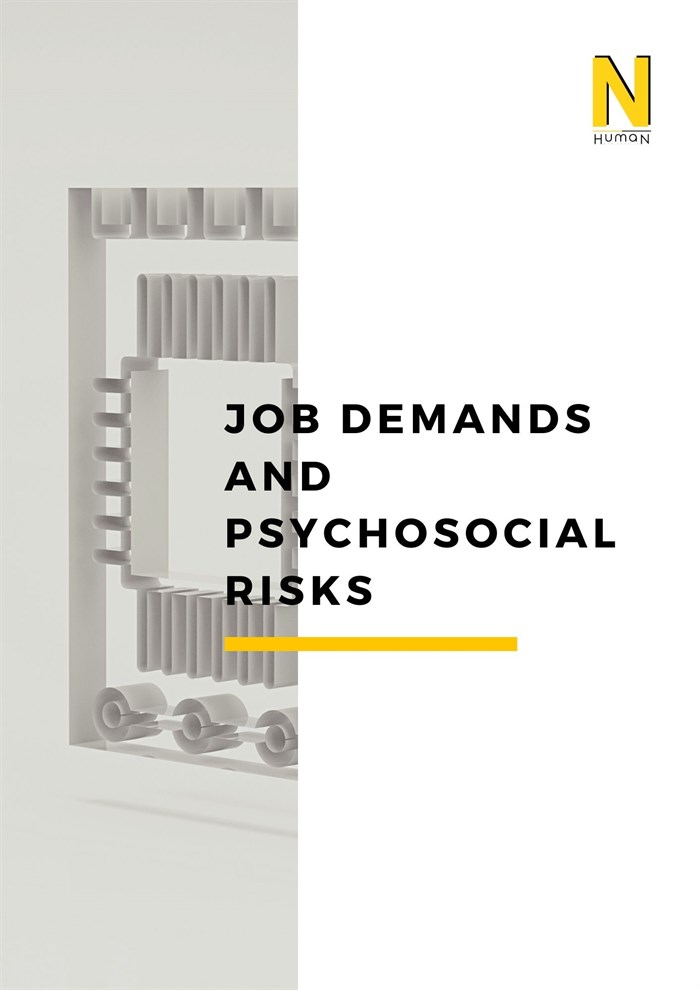Job Demands
Job demands are all physical, psychological, social, or organizational aspects of a job that require physical, cognitive, or emotional effort.
A job demand can have negative as well as positive consequences, depending on the demand itself and the individual's ability to deal with it. Positive responses can be motivation, incentive, or job satisfaction, while negative responses can manifest as depression, anxiety, or burnout.
In general, there are four types of job demands:
Quantitative demands (for example, time pressure or amount of work); cognitive demands that primarily affect brain processes related to information processing (for example, the difficulty of the job), emotional demands that express the effort required to cope with emotions that will arise in organizationally demanding tasks during interpersonal communication, and physical demands associated with the musculoskeletal system (i.e., motor and physical demands of behavior) aspects (eg dynamic and static loads).
Job Demands and Psychosocial Risks
Many people are motivated by the challenges they face in their work environment. On the other hand, pressure from job demands and other related stressors, combined with perceived coping ability, can lead to an experience of stress when excessive and prolonged.
Experiencing coping challenges at work can be good for us psychologically and physically and can encourage learning new skills. An employee's sense of the challenge of his job is an important component of developing and maintaining a psychosocially healthy work environment.
However, excessive and prolonged pressure and demands that exceed the perceived resources, abilities, and coping skills of the employee can lead to the emergence of psychosocial risks related to job demands.
A detailed description of psychosocial risks, including the psychosocial risks that may arise from job demands, was made by Cox and Griffiths; task design, workload and pace of work, work schedule, freedom of control and decision, work environment and equipment, organizational culture and function, interpersonal relations at work, role in the organization, career development and work-life balance.
In general, task design implies a lack of diversity or short work cycles, inadequate use of skills, fragmented or meaningless work, high uncertainty, and inappropriate frequency of social contact.
Workload and work pace are considered to mean high time pressure, excessive workload, or low workload, which are constantly subject to deadlines.
Work schedule factors include shift work, night shifts, unpredictable hours, inflexible work schedules, and long or unsocial hours.
Decision latitude/control includes lack of employee control over workload or pacing or low involvement in decision-making processes
Work environment and equipment include inadequate equipment availability, equipment suitability or maintenance, and poor environmental conditions (such as lack of space, insufficient lighting, or excessive noise).
Organizational culture and function include poor communication, lack of definition of organizational goals, and low levels of support mechanisms for problem-solving and personal growth.
Interpersonal relationships in the workplace include assessing situations of social or physical isolation, interpersonal conflict, lack of social support, poor relationships with superiors, and potential bullying or harassment.
Role and career development in the organization; These include role ambiguity, role conflict and responsibility towards people, career stagnation and uncertainty, job insecurity, under-promotion or over-promotion, low pay, and low social job prestige.
Finally, work-life balance, the conflicting demands of work and home refer to low job support and dual-career issues in social life.
CONCLUSION
Job demands have been identified as one of the most common sources of work-related stress. For example, long working hours and busy work shifts, high time pressure, ergonomic problems, and poor physical conditions are at high risk of causing stress and long-term negative consequences.
The negative short-term and long-term effects of such demands can be mitigated and overcome by business resources such as control over the work process, job satisfaction, and rewards. To develop these solution mechanisms, it is important to evaluate the psychosocial risks of job demands within the scope of the enterprise and to plan the actions to be taken for the relevant risk areas.
N_HumaN Danışmanlık provides comprehensive services for the assessment of psychosocial risks in businesses and the implementation of improvements in the identified risk areas within the scope of the 5-Stage İYRS Model.

References
1. European Foundation for the Improvement of Living and Working Conditions (2007). ‘Work-related stress. Retrieved 11 February 2013, from www.eurofound.europa.eu
2. Workplace Health and Safety Queensland, ‘Work demands', Department of Justice and Attorney-General, Queensland, 2012.
3. Schaufeli, W. & Bakker, Ar., ‘Job demands, job resources, and their relationship with burnout and engagement: a multi-sample study.’ Journal of Organizational Behaviour, Vol. 25, 2004, pp. 293-315. DOI: 10.1002/job.248
4. Cox, T. & Griffiths, A.J. (1995). ‘The assessment of psychosocial hazards at work.’ In M.J. Shabracq, J.A.M. Winnubst & CL Cooper (Eds.) Handbook of Work and Health Psychology. Chichester: Wiley & Sons.
5. International Labour Organization (2020). İş Yerinde Stres: Ortak Bir Zorluk.(N Human Danışmanlık, Çev.) İzmir: N Human Danışmanlık Yayınları (Orijinal Basım Tarihi 2016) ISSN: 9786050646801